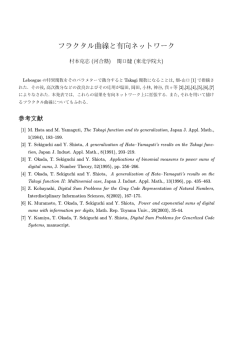
確率的最大不等式,狭義可算性,および関連する話題
2014 年 6 月 13 日 統計数理研究所 オープンハウス
確率的最大不等式,狭義可算性,および関連する話題
西山 陽一
数理・推論研究系 准教授
1. A stochastic maximal inequality
2.1. Hint from discussion to define “separability”
• The most important special case of the Doob-Meyer decomposition equation
for 1-dimensional martingale difference sequence (ξk )k=1,2,... is:
[A] Ledoux and Talagrand (1991) used the following definition:
[
]
[
]
E ∗ sup X(h) := sup E max X(h) ,
n
∑
2
ξk =
k=1
n
∑
E[ξk2 |Fk−1] + Mn.
h∈H
k=1
X(h, ω) ∈ {X(e
h, ω); e
h ∈ H∗, ρ(h, e
h) < ε},
k=1
and in this case, we can compute as
[
]
[Key points of the proof ]
• Let X = (X 1, ..., X d) be a d-dimensional semimartingale.
E sup X(h) = E
h∈F
where the supF ⊂H is taken over all finite subsets F of H.
[B] Ledoux and Talagrand (1991) gives also the definition of separability of
random field; there exists a negligible set N and a countable set H∗ ⊂ H
such that, for every ω ∈ N c, every h ∈ H and ε > 0,
• Our stochastic maximal inequality gives an inequality analogue to the
Doob-Meyer decomposition for maxima of finite number of martingale difference sequences (ξki )k=1,2,..., i ∈ IF , given by
2
[
]
n
n
∑
∑
K
i )2 F
ξki ∧ K≤
max
E
max
(ξ
+ Mn .
k−1
k
−K
i∈IF
i∈IF
1−e
k=1
F ⊂H
h∈H
]
[
sup X(h) .
h∈H∗
Itˆ
o’s inequality. If f ∈ C 2 and it is concave, then it holds that
[D-1953] However, in Doob’s (1953) original definition of separability, the
dense subset T ∗ ⊂ T is taken to be not a countable set but a “sequence”.
f (Xt) − f (X0)
d ∫ t
d ∑
d ∫ t
∑
∑
1
i
≤
Dif (Xs−)dXs +
Dij f (Xs−)d⟨X c,i, X c,j ⟩s.
2
0
0
i=1
i=1 j=1
∑
• Put Xti := k≤t ξki and define Y i’s by
{
}
j
Yt1 = 1 |Xt1| ≥ max |Xt | ,
1<j≤m
{
}
j
j
Yti = 1 |Xti| > max |Xt |, |Xti| ≥ max |Xt | ,
1≤j<i
i<j≤m
{
}
j
Ytm = 1 |Xtm| > max |Xt | .
[D-2004] However, Joseph L. Doob did not explicitely write the definition
of the word “sequence”.
2.2. Definitions and facts
i = 2, ..., m − 1,
1≤j<m
• Then it holds that
2
m
∑
∑
(Xti)2Yti.
max
ξki = max (Xti)2 =
1≤i≤m
1≤i≤m
i=1
k≤t
• Applying Itˆo’s inequality to f (e
x1, ..., x
em, y1, ..., ym) = ψ (
have
m
∑
ψ (Xti)2Yti
≤
≤
=
i=1
m ∫ t
∑
i=1 0
m ∫ t
∑
i=1 0
m ∫ t
∑
i=1 0
i d(X i )2 +
ψ ′(Zs−)Ys−
s
m ∫ t
∑
i=1 0
[Definitions]
• A well-ordering < for a set I is called σ-ordering if it satisfies that
#⟨i⟩ < ∞ for every i ∈ I, where ⟨i⟩ := {j ∈ I; j < i}.
• A σ-ordered set (I, <) is called a sequence.
• A set I is said to be a pre-sequence or strictly countable if it is possible
to assign a σ-ordering “<” to I.
• A random feild {X(h); h ∈ H} indexed by a semimetric space (H, ρ) is
said to be strictly separable if there exists a negligible set N and a strictly
countable set H∗ ⊂ H such that, for every ω ∈ N c, every h ∈ H and ε > 0,
∑m
eiyi), we
i=1 x
X(h, ω) ∈ {X(e
h, ω); e
h ∈ H∗, ρ(h, e
h) < ε}.
[Facts]
• About N:
[A1] (N, <), where “<” is the usual ordering for N, is a sequence.
i )2dY i
ψ ′(Zs−)(Xs−
s
[A2] (N, <b), where “<b” is a “bad” well-ordering for N, may not be a
sequence.
i d(X i )2
ψ ′(Zs−)Ys−
s
[A3] N, with no ordering, is a pre-sequnce (i.e., a strictly countable set).
• Propreties we actually use:
i d⟨X i⟩ + M ,
ψ ′(Zs−)Ys−
s
t
[B] For any given pre-sequence I, it holds for any σ-ordering and any mapping
x : I → R,
lim max x(in) = supx(i),
where Z = (X 2, Y ), M is a local martingale starting from zero and
⟨X i⟩t =
∑
E[(ξki )2|Fk−1].
k≤t
2. Strict countability
Under which condition on the set I does the following “monotone convergence
argument” hold true?
[
]
[
]
[
]
lim E max |Xi| = E lim max|Xi| = E sup|Xi| .
m→∞
[D-1984] After three decades later, Doob (1984) again suggested how to
define the concept of “separability” based on “cofinal sequence”.
i∈Im
m→∞ i∈Im
i∈I
m→∞ 1≤n≤m
i∈I
where “in, n ∈ N” denotes the corresponding “natural numbering”.
• Properties on union operations:
∪d
(k)
[C1] If each I is strictly countable, then k=1 I(k) is strictly countable.
[C2] The above is not true if d = ∞. Actually, N × N is not strictly
countable.
[C3] Any set which can be expressed in the form of an infinite disjoint unifon
of infinite sets is not strictly coutable.
[C4] Even the limit of increasing sequence of finite sets may not be strictly
countable in general.
© Copyright 2025
